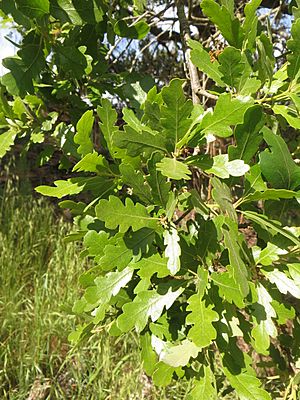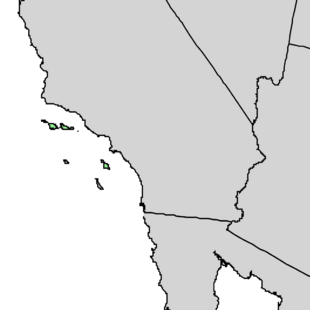Quercus × macdonaldii facts for kids
Quick facts for kids Quercus × macdonaldii(Quercus macdonaldii) |
|
|---|---|
 |
|
| Leaves of Quercus ×macdonaldii from an individual on Santa Cruz Island, California | |
| Conservation status | |
| Scientific classification | |
| Kingdom: | |
| (unranked): | |
| (unranked): | |
| (unranked): | |
| Order: | |
| Family: | |
| Genus: | |
| Species: |
Q. × macdonaldii
|
| Binomial name | |
| Quercus × macdonaldii Greene & Kellogg (pro sp.)
|
|
| Synonyms | |
|
Quercus macdonaldii − Greene |
|
The MacDonald's oak, also known as Quercus × macdonaldii, is a very special and rare type of oak tree. It's part of the Fagaceae family, which includes many well-known trees like beeches and chestnuts. This unique oak is found in only a few places in the world.

Where MacDonald's Oak Lives
This rare oak tree grows only in one specific place: the California Channel Islands. These islands are located off the coast of Southern California. You can find MacDonald's oak on Santa Cruz Island, Santa Rosa Island, and Santa Catalina Island.
It likes to live in areas called chaparral and woodlands. These are places with thick bushes and trees. The oak usually grows in canyons and on hillsides. It prefers elevations below about 600 meters (about 1,970 feet).
Sadly, Quercus × macdonaldii is considered a Vulnerable species. This means it's at risk of disappearing. Its biggest threat is habitat loss, which happens when its natural home is damaged or taken away.
Understanding Its Name: Taxonomy
The scientific name for this tree is Quercus × macdonaldii. The "×" in its name is a special sign. It tells us that this oak is a hybrid. A hybrid plant is like a mix of two different parent plants.
Scientists have learned that MacDonald's oak is a natural hybrid. This means it formed on its own in nature. It's a mix of two other oak species: Quercus pacifica and Quercus lobata. It might even have genes from other oak types too!


